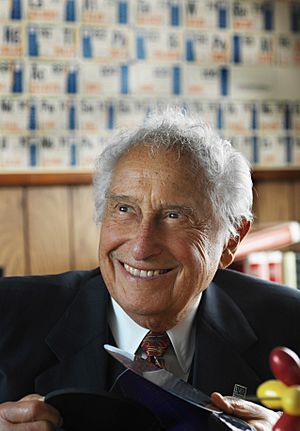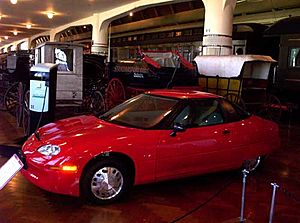Stanford R. Ovshinsky facts for kids
Quick facts for kids
Stanford Robert Ovshinsky
|
|
|---|---|

Stanford R. Ovshinsky, August 2005
|
|
| Born |
Stanford Robert Ovshinsky
November 24, 1922 Akron, Ohio, U.S.
|
| Died | October 17, 2012 (aged 89) |
| Nationality | American |
| Occupation | engineer, scientist and Inventor |
| Known for | Nickel–metal hydride battery Phase-change memory |
| Spouse(s) |
|
Stanford Robert Ovshinsky (born November 24, 1922 – died October 17, 2012) was an American engineer, scientist, and inventor. Over 50 years, he received more than 400 patents. Most of his inventions were in energy and information.
Many of his ideas have changed how we live. For example, he helped create the nickel-metal hydride battery. These batteries are in laptops, digital cameras, cell phones, and electric and hybrid cars. He also worked on flexible solar panels, flat screen liquid crystal displays, and rewritable CD and DVD discs. Other inventions include hydrogen fuel cells and phase-change memory.
Ovshinsky started the scientific field of amorphous materials. These are materials that don't have a regular, repeating structure like crystals. He studied them while researching the brain and how machines learn. He was also special because he was self-taught. He never went to college or graduate school. His love for science and his desire to help society drove his work.
In 1960, Ovshinsky and his wife, Iris Dibner, started Energy Conversion Laboratory in Detroit. They wanted to use science to solve big problems like energy and information needs. Their company, later called Energy Conversion Devices (ECD), became a leader in new inventions. Many of their products aimed to replace fossil fuels. Today, ECD continues to be a top company for solar energy and battery production.
After Iris Ovshinsky passed away in 2006, Ovshinsky started a new company, Ovshinsky Innovation LLC. He kept working on new energy and information technologies. In 2007, he married Rosa Young, a physicist who had worked with him.
Contents
Early Life and Social Values
Stanford Ovshinsky grew up in Akron, Ohio, a city known for its rubber industry. His parents were Jewish immigrants from Eastern Europe. They taught him about hard work and helping others.
During the Great Depression, he saw many people struggling. This made him care deeply about social justice, labor rights, and civil rights. His father, who collected scrap metal, was a big influence. Stan learned from him and from the Akron Workmen's Circle, a group that believed in fairness for everyone.
Early Inventions and Studies
Working as a Machinist
Before finishing high school in 1941, Ovshinsky worked as a tool maker and machinist. During World War II, he moved to Arizona and worked at a Goodyear plant. He later returned to Akron and started his own machine company, Stanford Roberts.
There, he invented the Benjamin Center Drive. This was an automatic, high-speed lathe (a machine that shapes materials). It was very useful for making artillery shells quickly during the Korean War.
Exploring Intelligent Machines
In 1951, Ovshinsky moved to Detroit to work for the Hupp Motor Company. He continued to study how humans and machines think. He even invented electric power steering for cars.
He and his brother, Herb Ovshinsky, later started General Automation. There, Stan kept researching intelligent machines and new energy technologies. He also studied the human brain and nerve diseases. His early ideas about nerve impulses led him to work with Wayne State Medical School on brain research.
The Ovitron: A New Kind of Switch
In the late 1950s, Ovshinsky combined his studies into a new invention. He brought together ideas from brain science and cybernetics (the study of control and communication). He invented a mechanical model of a nerve cell called the Ovitron. His brother Herb helped build it.
The Ovitron was a thin-film switch made from amorphous materials. Ovshinsky wanted to copy how nerve cells learn. He realized that nerve cells change and adapt, a process called plasticity. To do this, he made very thin layers of amorphous material. This was an early step in using nanostructures (tiny structures). He used elements like sulphur, selenium, and tellurium, which are called chalcogenides. He continued to use these materials in his inventions for many years.
Innovations from 1960 Onward
Energy Conversion Laboratory
On January 1, 1960, Ovshinsky and Iris Dibner started Energy Conversion Laboratory (ECL). They wanted to use his inventions to solve big problems in information and energy. Iris had a strong science background, with degrees in zoology, biology, and biochemistry.
Ovshinsky continued to work with his special chalcogenide materials. He found that these materials could act as semiconductors when a small voltage was applied. This became known as the "Ovshinsky Effect." He used this effect to build new electronic and optical switches.
Two important inventions were his Ovonic Phase Change Memory and his Threshold Switch. The phase-change memory later became the basis for rewritable CDs and DVDs. It is also used in new computer memory today. Unlike others who worked with solid, bulky materials, Ovshinsky focused on thin films and nanostructures. He patented his work in 1961 and began licensing his phase-change memory in 1962.
Energy Conversion Devices
By 1963, the Ovshinskys needed more money for ECL. They wanted a famous scientist to confirm their work was important. Nobel Laureate John Bardeen, who helped invent the transistor, recognized the value of Ovshinsky's work. He sent physicist Hellmut Fritzsche to visit. Fritzsche was very impressed and helped attract other scientists to the lab.
Many famous scientists visited ECL, becoming friends or collaborators. The lab became a unique place where people from different backgrounds worked together. In 1964, they changed the company name to Energy Conversion Devices (ECD) and moved to a bigger location.
ECD kept developing electronic memory, batteries, and solar cells. They put most of their profits back into research. This led to new industries, like flat screen liquid crystal displays. ECD also made money from nickel-metal hydride batteries, which were important for laptops and are still used in hybrid cars. They also developed a way to make solar cells "by the mile" using a continuous machine. This helped them build larger solar energy systems.
Ovshinsky Innovation LLC
After Iris Ovshinsky's death in 2006, Stan Ovshinsky left ECD. In 2007, he started a new company, Ovshinsky Innovation LLC, with Rosa Young, whom he married. He continued to work on energy and information science.
His new company focused on a new type of solar power plant. This plant aimed to make solar energy cheaper than coal. This was part of his lifelong goal to replace fossil fuels and create new jobs.
ECD is known for developing solar roofing shingles and making the best flexible thin film solar panels. Ovshinsky's independent and groundbreaking work has led some to compare him to Albert Einstein. Because of his many inventions in digital memory, solar energy, battery technology, and hydrogen storage, he is often compared to Thomas Edison. Many also call him "the modern world's most important energy visionary."
General Motors and Electric Cars
In the early 1990s, the auto industry created the US Auto Battery Consortium (USABC). Ovshinsky believed this group tried to slow down the development of electric cars. He said they prevented his battery patents from becoming widely known.
According to Ovshinsky, the auto industry claimed that NiMH batteries were not ready for cars. Members of the USABC, including General Motors, Ford, and Chrysler, even threatened to sue Ovshinsky. They didn't want him to promote NiMH batteries for electric vehicles or lend them to smaller companies. Critics say the big car companies wanted to convince people that electric cars were not possible.
In 1994, General Motors bought a large share of Ovonics' battery development. This included patents for making large NiMH batteries. The plan was to use these batteries in GM's EV1 electric car. However, the EV1 program was stopped by GM before the new NiMH battery could be fully used. This happened even though tests showed the Ovonics battery could make the EV1 go over 150 miles on a single charge.
Death
Stanford Ovshinsky passed away on October 17, 2012, at the age of 89. He died from prostate cancer in Bloomfield Hills, Michigan.
Awards and Recognition
Ovshinsky wrote over 300 scientific papers and received many awards for his work.
Memberships
- Fellow of the American Physical Society
- Fellow of the American Association for the Advancement of Science
- Fellow of the Engineering Society of Detroit
Awards and Honors
- 2005 Innovation Award for Energy and the Environment by The Economist
- American Solar Energy Society Hoyt Clarke Hottel Award
- Karl W. Böer Solar Energy Medal of Merit
- International Association for Hydrogen Energy Sir William Grove Award
- 2007 Walston Chubb Award for Innovation
- Frederick Douglass/Eugene V. Debs Award (2006)
- Engineering Society of Detroit Lifetime Achievement Award (2008)
- Environmental Hall of Fame 2008 Award (Father of Thin-Film Solar Energy)
- IEEE Vehicular Technology Society Presidential Citation (2009)
- 2009 Thomas Midgley Award from the American Chemical Society
- Finalist for the prestigious European Inventor Award 2012 for his NiMH batteries.
- Named "Hero for the Planet" by TIME magazine (1999)
- Inducted into the 2005 Solar Hall of Fame
- Diesel Gold Medal from the German Inventors Association (1968)
- Honorary Calgarian award in Calgary, Canada (2012)
- Received several Honorary Doctorates from universities like Kettering University, University of Michigan, and Wayne State University.
- In 2015, Ovshinsky was inducted into the National Inventors Hall of Fame.
See also
 In Spanish: Stanford Robert Ovshinsky para niños
In Spanish: Stanford Robert Ovshinsky para niños
- Harold McMaster


